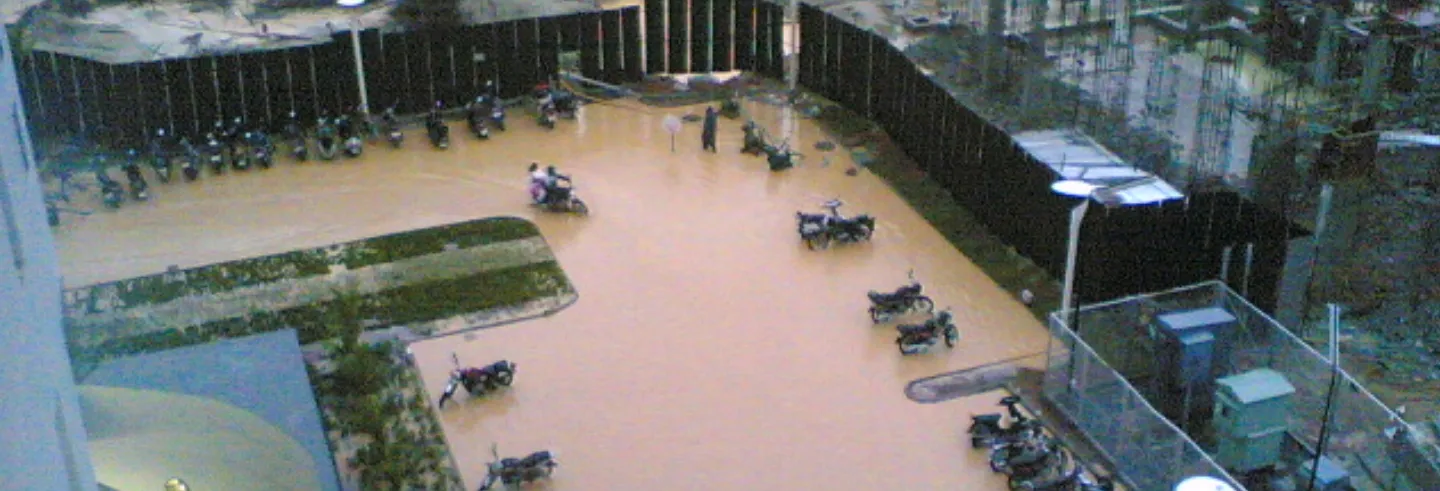Neecha Nagar was the first film from India to go to the inaugural Cannes Film Festival in 1946 and win the Palme D’or. Neecha Nagar, or the “Lowly City”, was an urban tale of the poor living in the parts of a city that were prone to flooding. In the film, a rich industrialist directs his sewage lines to the lower parts of a city, leading to an outbreak of disease.
Paradise, a 2019 Korean film that went on to win the Palme D’Or that year and four Academy awards the next, also told a compelling story of how a city is vertically graded in terms of class. Both films show how water, and the way it flows across cities, has shaped urban life and its class markers. A city like Bengaluru is always anxious about the availability of drinking water on the one hand, but on the other, water also has played a deeply destructive role. Water’s double-edgedness makes it a complex force. Affluence and poverty in the city have been organised around flows of water and have historically shaped dignity of life.
A lot has been said and written about the recent floods in Bengaluru. Faulty planning, real estate lobbies, and corruption led to the ecological crisis that the city’s residents are living through now. Corrupt governments and greedy corporations have long colluded to build illegally in Indian cities. Malini Ranganathan’s work on the risk of floods in Bengaluru notes the urban development over old storm drains began years ago (Ranganathan 2015). She shows how places like Bommanahalli, which are low-lying areas, were always prone to flooding. Tech parks and residential complexes were largely able to insulate themselves from floods even while slums in the same areas were inundated. This was a fact of life in the city for several years.
Our planning, or lack of it, has miserably failed to prevent urban floods, which have now become symptoms of the climate crisis. Though nobody is deluded about either corruption or the lack of political will, the public response to these events is diffused before it can generate much talk about accountability. What does this say about the nature of our democracy?
All our cities are, in a sense, ‘Neecha Nagars’, which has been easy to forget in the midst of the glitz and glamour of neoliberal infrastructure.
This is not Bangalore’s problem alone. Even Delhi, the national capital, struggles with problems like this. Scores of unauthorised or poor localities with no proper sewage lines have had no way of tackling their rising volume of waste other than raising the level of their roads—leading to houses that are sinking into the sewage. The poor have always lived in spaces that are always Neecha Nagar, which means Neecha Nagar is many cities at once. All our cities are, in a sense Neecha Nagars, which has been easy to forget in the midst of the glitz and glamour of neoliberal infrastructure. New airports, new amphitheatres, new malls, and new tech parks, all of which are privately owned and managed, continue to dominate our story of development.
Bengaluru’s post liberalisation transformation has been quite rapid. Armed with money from venture capitalists, the booming IT sector, and some of the energy that drove start-ups, builders “developed” the city’s low-lying areas in the name of accommodating a new workforce. These sparsely populated areas soon became the “Silicon Valley” of India. And its inhabitants, armed with confidence and money, were the drivers of a new India—self-made and entrepreneurial.
Neoliberalism provided the market with a “solution” for everything. Crowded hospitals? No problem. A slew of private hospitals, which resembled expensive hotels, cropped up. Terrible teachers in schools? The market provided private schools the rich could pay for and demand accountability from. The rich bought their way out of everything, while public infrastructure, which only the poor were accessing, was left to rot.
Post-1990s, urban planning ceased being imagined as a comprehensive plan and pushed for a regime of flexible planning in the name of decentralisation (Maringanti 2012). Public private partnerships are now busy building a flyover here or a bullet train there without necessarily focusing on city-wide planning. With the state not showing the political will to build infrastructure, Bangalore’s entrepreneurs built their own—but to solve their private problems (Praveen Gopal Krishnan, 2022). Municipal governance has largely become defunct, so much so that the fact that elections to the Bruhat Bengaluru Mahanagara Palike (BBMP) have not taken place in the last two years has not even registered as an issue in the minds of the upper middle classes of Bangalore.
Planning’s complicity with big infrastructure means that there is interest only in money-guzzling ‘infrastructure’ with little utility.
This is not true of just Bangalore. It is true of the middle class in India in general. The middle-class have become privatised citizens fuelled by their own confidence in the global economy. No longer relevant, the state quickly exited the rich post-1990s. The privatised citizens do not vote and resent paying taxes for “services” they do not get. And the structural problems of the city continued to be met with a “not-in-my-backyard” attitude.
The state has also radically changed. Planning’s complicity with big infrastructure means that there is interest only in money-guzzling “infrastructure” with little utility. The new, fully air-conditioned Sir M. Visvesvaraya Railway Terminal in Bengaluru, which resembles an airport, is one such example. It is wasteful and ill-connected to the city by public transport. When cities claim that they will become like Paris or London, this is precisely what they mean. For the privatised citizen too, such “development” matters the most. Why should Bangalore not look like a Shanghai? After all, it is the tech face of the country and deserves to look like a “world-class city”. So far, so good. The rise of the rich, privatised citizen went well with this kind of development that refused to resolve the structural issues that people faced.
But the recent floods have changed all that. Airports were under water; so were the villas of the rich. Money could earlier buy development and comfort—but the limits to doing so now are starkly clear. Flooding and waterlogging were no longer “poor people’s problems”. The rich are now realising that they cannot shield themselves from everything. Their confidence is shaken. We all live in Neecha Nagar today.
Yet, the moneyed class refuses to acknowledge the root cause of the problem. As soon as the floods hit, public anger was directed at the migrants to the city, not the elected representatives. Bengaluru, a city known for its “cosmopolitanism”, witnessed an outpouring of rage against migrants—migrants who refused to learn Kannada, who had made fortunes in the city but had no loyalty to it. They had bought property that used to be lakes earlier and were now complaining about the city— #leaveBengaluru began to trend on social media. Hateful comments asking migrants to go back to their “shitty cities” dominated social media.
[T]he demolition of the twin towers in Noida last month became a symbol of strong governance. It is now being seen as a public victory against the corrupt.
This urban crisis mirrors a political crisis within our democracy. The middle class revealed its own internal schisms. The underlying tension between the local Kannadiga elite and the north Indian elite came to the fore in its full force. However, despite the historical uneasiness of the relations with each other, they have been united in force by a nationalist agenda also. Over the last three decades, the privatised citizen has become a supporter of neoliberal governance, eager to give up welfare mechanisms in favour of snazzy infrastructure. For the poor, welfare has descended to being doles and “freebies” from a state that is increasingly becoming populist. While the urban middle class has declared war on a populist state that gives out “freebies” to the poor, it refuses to acknowledge its complicity with the same state. The populist state is also known to draw lines between its “friends” and “enemies” and the privatised middle class has overwhelmingly participated in discussions about this division.
Populism has now given way to brash declarations of who our public enemies are. In the moment of the present crisis, where the local administration is in shambles and the privatised modes of governance does not yield much, nobody quite knows who to blame, and much less how to acknowledge our own historic complicity. Not surprisingly, the demolition of the twin towers in Noida last month became a symbol of strong governance. It is being seen as a public victory against the corrupt. But amid the applause and cheers, what has been lost is genuine accountability. Public spectacles enable the populist state to deflect responsibility, and the middle class has only lapped them up.
Spectacles are events specifically designed to show off state power. The response to every crisis is a new spectacle. The Covid pandemic got us on to our balconies to bang plates. And now that demolitions have become the spectacle of the season, the Bangalore floods have unleashed demands that all unauthorised construction on storm drains be demolished. On Karnataka Chief Minister Basavraj Bommai’s instructions, 696 encroachments on storm drains were being demolished in the Mahadevapura area of Bengaluru even as this was being written. Quite tellingly, the government response does not seem to have come from an assessment of whether the demolitions would help and to what extent. In a compromised democracy, the state learns to respond to public issues through spectacles, and the most powerful of them right now are demolitions.
In an age of populism, most of the citizenry has a clear understanding of all that is wrong but choose to look for easy solutions.
The migrants are now public enemies for being disloyal to the city, just as they were earlier charged with spreading the Covid-19 virus. The focus may keep shifting. We will keep moving amidst sets of friends and enemies without really asking how we got here in the first place.
This ecological problem of floods is not just a story of the failure of governance and planning. It is also a failure of our democracy. Bengaluru may be Neecha Nagar today, but the 1946 film had a different resolution in the form of collective resistance. In an age of populism, most of the citizenry has a clear understanding of all that is wrong, but they choose to look for easy solutions. The spectacles such as demolition are there for this purpose—they are easy targets for our collective public ire. This ire may be collective, but these collectives defy the very nature of democratic collective politics. A democratic deficit defines the basis of this new politics.
We are told to look for enemies within—sometimes the Bangladeshi; at other times, the north Indian migrant—and we do that. We are so dazzled by the posh infrastructure that is going up or coming down that we fail to think that these loud events are all that strong governments are about. Steven Levitsky and Daniel Ziblatt wrote an acclaimed book in 2019 titled How Democracies Die, where they argued that democracies do not die by violent coups and armed resistance but silently by what elected representatives do. I am not sure how silent our own unravelling will be. In a time of climate crisis, when heat waves and floods are becoming commonplace, our democracy will probably go down amid loud cheers and arm flexing by the state.
The author would like to thank Anwesha Ghosh for her comments on the draft.
Sushmita Pati is with the National Law School of India University, Bengaluru.








